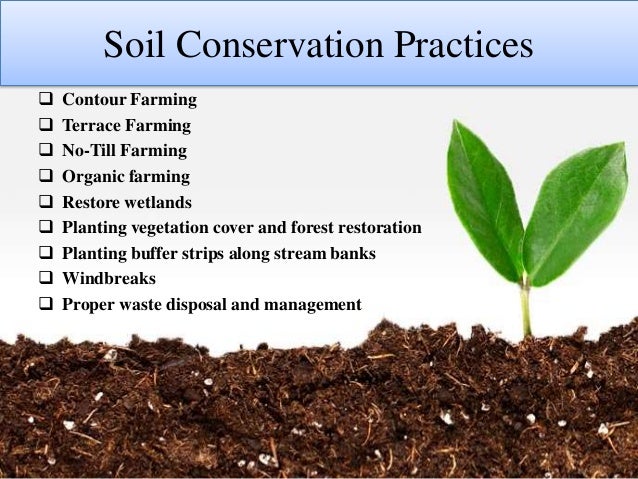Conservation Agriculture Cover Cropping And Soil Conservation Practices
Soil conservation plays a crucial role in maintaining the health and fertility of our lands. It is an essential practice that aims to prevent soil erosion, improve soil quality, and promote sustainable agriculture. In this article, we will explore the importance of soil conservation and provide various ideas, recommendations, and questions related to this topic.

What is Soil Conservation?
Soil conservation refers to the efforts made to protect and manage the soil to prevent its degradation. It involves implementing techniques and practices that maintain or improve the soil's physical, chemical, and biological properties. By conserving soil, we can ensure its longevity and productivity for future generations.
Ideas For Soil Conservation
1. Terrace Farming: Building terraces or step-like structures on slopes can prevent soil erosion by slowing down the flow of water and allowing it to infiltrate into the soil.
2. Crop Rotation: Rotating crops from season to season helps maintain soil fertility by preventing the depletion of specific nutrients and reducing the risk of pests and diseases.
3. Cover Cropping: Planting cover crops, such as legumes or grasses, during the off-season helps protect the soil from erosion, improves soil structure, and enriches it with organic matter.
4. Conservation Tillage: Instead of plowing the entire field, conservation tillage techniques, like minimum tillage or no-till farming, disturb the soil less and effectively reduce erosion and nutrient loss.
5. Windbreaks: Planting trees, shrubs, or fences as windbreaks can shield the soil from strong winds, preventing wind erosion and the loss of valuable topsoil.
6. Contour Farming: Cultivating crops along the contour lines of the land forms ridges that act as barriers against water erosion and promote water infiltration.
7. Mulching: Applying a layer of organic or inorganic material, such as straw, leaves, or plastic, to the soil surface helps regulate soil temperature, retain moisture, and prevent erosion.
8. Proper Irrigation: Implementing efficient irrigation systems and practices, such as drip irrigation or precision sprinklers, minimizes water runoff and optimizes water usage, reducing soil erosion.
9. Soil Testing: Regularly testing the soil's nutrient levels and pH helps farmers adjust fertilization practices, ensuring proper nutrient availability for plants without overusing fertilizers.
10. Education and Awareness: Promoting awareness about the importance of soil conservation among farmers, policymakers, and the general public can encourage the adoption of sustainable land management practices.
Recommendations For Soil Conservation
1. Government Support: Governments should provide incentives, subsidies, and technical assistance to farmers who adopt soil conservation practices, making it financially feasible and socially rewarding.
2. Research and Innovation: Investing in research and innovation can lead to the development of new soil conservation techniques and technologies that are more efficient and sustainable.
3. Collaboration and Partnerships: Encouraging collaboration between farmers, agricultural organizations, and environmental agencies can facilitate the exchange of knowledge and best practices in soil conservation.
4. Conservation Laws and Regulations: Governments should enact and enforce laws and regulations that promote soil conservation, such as restricting harmful agricultural practices and promoting sustainable land management.
5. Land Use Planning: Proper land use planning can ensure that agricultural activities are conducted in suitable areas, considering factors like soil type, slope, and vulnerability to erosion.
6. Farmer Training and Education: Providing training and educational programs on soil conservation to farmers can enhance their knowledge and skills in implementing sustainable practices.
7. Soil Health Assessment: Encouraging farmers to regularly assess the health of their soil through testing can help them make informed decisions regarding soil management and conservation techniques.
8. Soil Conservation Incentives: Governments and organizations can offer financial incentives, rewards, or recognition to farmers who excel in soil conservation and sustainable farming practices.
9. Conservation Research Funding: Allocating funds for scientific research focused on soil conservation can contribute to the development of effective and evidence-based soil management strategies.
10. International Cooperation: Global collaboration and knowledge-sharing can lead to the adoption of the best soil conservation practices worldwide, ensuring the preservation of soil resources on a larger scale.
Listicle of Soil Conservation Techniques
- Contour Plowing
- Strip Cropping
- Terracing
- Windbreaks and Shelterbelts
- No-Till Farming
- Crop Rotation
- Cover Cropping
- Conservation Buffers
- Buffer Strips
- Grassed Waterways
Question & Answer
Q: Why is soil conservation important?
A: Soil conservation is important because it helps prevent soil erosion, maintain soil fertility, protect water quality, and promote sustainable agriculture. It ensures the long-term productivity and health of our lands.
Q: What are the consequences of soil erosion?
A: Soil erosion can lead to reduced agricultural productivity, loss of topsoil, water pollution, increased flooding, and desertification. It also affects ecosystems by degrading habitats and reducing biodiversity.
Q: How can farmers practice soil conservation?
A: Farmers can practice soil conservation through techniques such as terrace farming, crop rotation, cover cropping, conservation tillage, windbreaks, contour farming, mulching, proper irrigation, and soil testing, among others.
Summary of Soil Conservation
In summary, soil conservation is a critical practice that aims to protect and manage the soil to prevent degradation. By implementing various techniques and practices, such as terrace farming, crop rotation, and cover cropping, we can maintain soil fertility, prevent erosion, and promote sustainable agriculture. It is essential that governments, farmers, and society as a whole prioritize soil conservation to ensure the long-term viability of our lands and secure food production for future generations.
This article provided insights into soil conservation and presented a range of ideas, recommendations, and information related to this vital topic. Through collaborative efforts and the adoption of sustainable land management practices, we can preserve our soil resources and create a more resilient and productive agricultural system.



Post a Comment for "Conservation Agriculture Cover Cropping And Soil Conservation Practices"